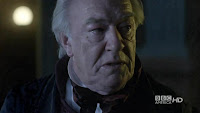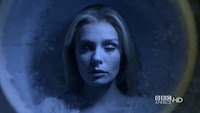A Christmas Carol Moffatized
 There is a school of thought that goes out of its way to excuse the garish excesses of Doctor Who Christmas specials on grounds that they are, well, Christmas specials. These are the same apologetic members who have indulged the worst of the Russell Davies era, an overabundance of silliness, visual chaos, and Disneyesque non-narratives. In their heart of hearts I suspect some of them confess the truth: that The Runaway Bride (2006), Voyage of the Damned (2007), The Next Doctor (2008), and The End of Time (2009) are so bloody awful they could turn a saint into a scrooge, quite amusingly, the opposite of their intended effect.
There is a school of thought that goes out of its way to excuse the garish excesses of Doctor Who Christmas specials on grounds that they are, well, Christmas specials. These are the same apologetic members who have indulged the worst of the Russell Davies era, an overabundance of silliness, visual chaos, and Disneyesque non-narratives. In their heart of hearts I suspect some of them confess the truth: that The Runaway Bride (2006), Voyage of the Damned (2007), The Next Doctor (2008), and The End of Time (2009) are so bloody awful they could turn a saint into a scrooge, quite amusingly, the opposite of their intended effect. Steven Moffat, however, is not Russell Davies, and the special he has served up this year is a gem. Gone is the usual cacophony and in its place a brilliant spin on a splendid classic, with plenty of soul. Though I tend to think Scrooge gets a bum rap, and I'm certainly no fan of the holiday season, there's something about A Christmas Carol I've always found endearing. It has little to do with Christmas per se, about which Scrooge's opinions actually have considerable merit. Dickens' story, at heart, is about a bitter man who wants to be happy but can't do so without taking a hard look behind, beside, and in front of him. That's a story for any season -- and one that happens to work perfectly in a Doctor Who context. Our Time Lord hero fills the roles of the ghosts of past and future, while sidekick Amy Pond appears as a hologram shade of the present, and between the two of them, with a little help from a dying woman, they manage to liberate a tormented man. That in the process they save over 4000 people from dying at this man's whim is almost ancillary.
 The tormented Scrooge character is Kazran Sardick, an industrial overlord who despises all forms of good will, played brilliantly by Michael Gambon who channels even a bit of Albert Spica. Kazran is that grim (if not quite as oafish and vulgar), and I dare say this is Gambon's best performance since the infamous one in The Cook, The Thief, His Wife, and Her Lover. For him, unlike Spica, there is redemption in sight, though at serious emotional cost as he comes to terms with himself and the scars left by an abusive father.
The tormented Scrooge character is Kazran Sardick, an industrial overlord who despises all forms of good will, played brilliantly by Michael Gambon who channels even a bit of Albert Spica. Kazran is that grim (if not quite as oafish and vulgar), and I dare say this is Gambon's best performance since the infamous one in The Cook, The Thief, His Wife, and Her Lover. For him, unlike Spica, there is redemption in sight, though at serious emotional cost as he comes to terms with himself and the scars left by an abusive father.As for the Doctor, he's in top form, and at his most scheming. Frankly he hasn't been this manipulative since The Curse of Fenric, when he used Ace as a pawn and put her through sheer emotional hell. Though he tried to save as many people as possible in carrying out his personal vendetta against Fenric, there is no reason why he couldn't simply have taken the flask he trapped Fenric in and dumped it in a black hole like he did with the deity-skull in Image of the Fendahl. Likewise, in A Christmas Carol, there's no reason he couldn't have gone back in time to prevent the Starliner from taking off in the first place instead of jumping through hoops to rewrite a man's life on the slim hope that he'll change his mind. As in the Fenric classic, there's a part of me that thinks the Doctor is getting off on using people as pawns, rewriting their lives, as Kazran rightly charges, "to suit himself".
 Then there is Abigail, fated to die, who hit me rather hard with her transcendent singing. Never mind the absurdity of sharks being lullabied; I was almost as smitten as the young Kazran, and have to agree with Doug Chaplin, who writes:
Then there is Abigail, fated to die, who hit me rather hard with her transcendent singing. Never mind the absurdity of sharks being lullabied; I was almost as smitten as the young Kazran, and have to agree with Doug Chaplin, who writes:"I never thought I would be moved by seeing a woman singing 'In the bleak mid-winter' to calm a hungry Jaws-style Doctor-chasing shark lost in the fog. For a scene that on every rational level ought to have been ludicrous, it was astonishingly affecting. In a sense that stands as a paradigmatic miniature of the whole project. This episode manages both more powerfully and more naturally the kind of emotional payload that Moffatt strained after (rather ineffectually, I thought) in The Beast Below."That, incidentally, is a good comparison. While The Beast Below was decent (I gave it 3 stars), it was undercut by a lack of emotional payoff (unlike Abigail in A Christmas Carol, none of the kids who fall to the beast actually die) and a true sense of menace (after the opening scene, the Smilers weren't terribly threatening). Kazran is menacing on multiple levels. Not only will he let thousands of people die because he doesn't care enough to pull a switch, but there is a personal menace owing to inner demons. His transformation on account of Abigail, engineered by a master-manipulating Doctor, is so convincing, and I'm not sure whether that owes more to Michael Gambon's brilliant acting talents or the amazing script. Both are in full force as we see Kazran's nastiness crumble and give way to joy and inner peace, and he and Abigail share her last day of life together. In this sense, A Christmas Carol is a character piece -- a welcome change from the alien invasions of other Christmas episodes -- a lot like Dalek, Father's Day, Amy's Choice, and Vincent and the Doctor. That's pretty classic company, and Moffat's special is classic indeed.
Rating: 4 ½ stars out of 5.
Overview of all Doctor Who Christmas Specials
The Christmas Invasion -- 3 ½
The Runaway Bride -- 1
Voyage of the Damned -- 1
The Next Doctor -- 1
The End of Time -- 1
A Christmas Carol -- 4 ½




